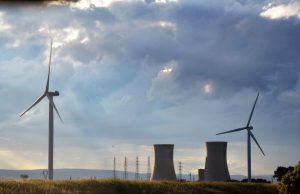Harvey Wasserman
(Originally published on August 1, 2017 at The Progressive)

Two of the last four commercial nuclear power plants under construction in the United States—both of them at the V.C. Summer site in South Carolina—have been cancelled. A decision on the remaining two, which are in Georgia, will be made in August.
“DING DONG, Summer is dead,” says Glenn Carroll, one of a core group of safe energy activists who have labored for decades to rid the southeast of these last four reactor projects. “This project has been a multi-billion-dollar disaster,” adds Stephen A. Smith of the Southern Alliance for Clean Energy. “We also call on Georgia Power and their utility partners to protect their customers from the similarly risky, mismanaged project” at the Vogtle site in Georgia. Should those two plants in Georgia also be cancelled, as seems increasingly likely, the United States would be free of all new commercial reactor construction for the first time since the 1950s. It would mark the definitive death of the dream of “too cheap to meter” radioactive energy, and end an era marked by massive cost overruns, soaring operating and maintenance expenses, a string of bankruptcies, two major meltdowns, an unsolved radioactive waste burden. The U.S. nuclear fleet, which Richard Nixon projected in 1974 would reach 1,000 reactors by the year 2000, never got higher than about 250 on line or in the works. Currently, 99 nuclear plants now operate in the United States. Five have shut in the last several years, with dozens more poised to follow, primarily due to their inability to compete with cheap gas, solar, and wind power. The fate of two reactors under construction in South Carolina was sealedJuly 31, with the unanimous vote of the board of the publicly owned Santee Cooper utility, which owns 45 percent of the project. The SCANA Corporation, which owns 55 percent, immediately followed with a statement saying it would also abandon construction, first proposed in 2007. Santee Cooper had been forced to raise rates five times to pay for construction at Summer. SCANA had raised them nine times. The two Summer reactors were slated to come on line in 2017 and 2018. The plants were to be Westinghouse AP 1000 designs, an upgraded version of the traditional light water reactor, of which some 430 are now licensed worldwide. Westinghouse pioneered and built the Pressurized Water Reactors that count for about half the world’s fleet. The AP 1000 was meant to provide a safer, more economical upgrade. But anunending stream of technical failures and soaring costs, as well as plummeting prices for gas, wind, and solar, and a drop in electricity demand, doomed the project. In a catastrophic financial failure, the four reactors it was building in South Carolina and Georgia drove Westinghouse into bankruptcy in March. (The iconic company dated back to the 1800s, when it won the contract to produce and deliver the first major loads of commercial electricity from Niagara Falls to the American northeast using technology developed by the legendary Nikola Tesla.) The Westinghouse bankruptcy has driven its parent company, Toshiba, to the brink of bankruptcy as well. Toshiba has offered some $2.2 billion to help finish the South Carolina project, but many doubt the giant company could actually make good on the pledge. Some $11 billion or more could be needed to finish the two new Summer reactors. Among other things, their owners have concluded that they could not meet a 2021 completion date to qualify for a critical federal tax credit. The news about the South Carolina plants is just the latest in a series of death shudders from the nuclear power industry. Reactors under construction at Olkiluoto, Finland, and Flamanville, France, are also massively over budget and teetering on the brink of collapse. In the American northwest, construction of five reactors for the Washington Public Power System triggered the largest municipal bankruptcy in U.S. history. More than forty reactors remain shut in Japan in the wake of the 2011 multiple meltdowns and explosions at Fukushima. Two U.S. reactors, Fermi I near Detroit and Three Mile Island in Pennsylvania, have also melted, along with the catastrophic 1986 explosion at Chernobyl. In Georgia, America’s two remaining nukes under construction at the Vogtle site are on the precipice. Though President Barack Obama provided the project with $8.3 billion in federal loan guarantees, the massive cost overruns, multi-year delays, Westinghouse’s bankruptcy and public anger over repeated rate increases have cast a long shadow. Worldwide, only China is still proposing to build large numbers of atomic reactors, a decision it will hopefully soon reverse. With massive hot water and steam emissions, plus carbon emissions in plant construction, waste management and the production of nuclear fuel, atomic reactors are a significant factor in unbalancing planetary weather patterns. Their cancellation, alongside the rise of green technologies like solar and wind power, bring the Earth a giant step closer to preservation. ““““““““““““““““““` See Harvey Wasserman’s Solartopia! Our Green-Powered Earth. He edits www.nukefree.org. This article is written with profound thanks to the great activists who helped make this vital victory happen.]]>